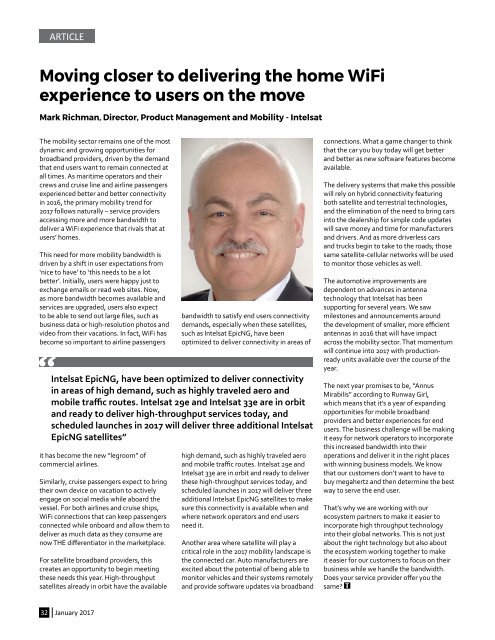Kingdom of Bahrain
TT_Jan17
TT_Jan17
Create successful ePaper yourself
Turn your PDF publications into a flip-book with our unique Google optimized e-Paper software.
ARTICLE<br />
Moving closer to delivering the home WiFi<br />
experience to users on the move<br />
Mark Richman, Director, Product Management and Mobility - Intelsat<br />
The mobility sector remains one <strong>of</strong> the most<br />
dynamic and growing opportunities for<br />
broadband providers, driven by the demand<br />
that end users want to remain connected at<br />
all times. As maritime operators and their<br />
crews and cruise line and airline passengers<br />
experienced better and better connectivity<br />
in 2016, the primary mobility trend for<br />
2017 follows naturally – service providers<br />
accessing more and more bandwidth to<br />
deliver a WiFi experience that rivals that at<br />
users’ homes.<br />
This need for more mobility bandwidth is<br />
driven by a shift in user expectations from<br />
‘nice to have’ to ‘this needs to be a lot<br />
better’. Initially, users were happy just to<br />
exchange emails or read web sites. Now,<br />
as more bandwidth becomes available and<br />
services are upgraded, users also expect<br />
to be able to send out large files, such as<br />
business data or high-resolution photos and<br />
video from their vacations. In fact, WiFi has<br />
become so important to airline passengers<br />
it has become the new “legroom” <strong>of</strong><br />
commercial airlines.<br />
Similarly, cruise passengers expect to bring<br />
their own device on vacation to actively<br />
engage on social media while aboard the<br />
vessel. For both airlines and cruise ships,<br />
WiFi connections that can keep passengers<br />
connected while onboard and allow them to<br />
deliver as much data as they consume are<br />
now THE differentiator in the marketplace.<br />
For satellite broadband providers, this<br />
creates an opportunity to begin meeting<br />
these needs this year. High-throughput<br />
satellites already in orbit have the available<br />
bandwidth to satisfy end users connectivity<br />
demands, especially when these satellites,<br />
such as Intelsat EpicNG, have been<br />
optimized to deliver connectivity in areas <strong>of</strong><br />
Intelsat EpicNG, have been optimized to deliver connectivity<br />
in areas <strong>of</strong> high demand, such as highly traveled aero and<br />
mobile traffic routes. Intelsat 29e and Intelsat 33e are in orbit<br />
and ready to deliver high-throughput services today, and<br />
scheduled launches in 2017 will deliver three additional Intelsat<br />
EpicNG satellites”<br />
high demand, such as highly traveled aero<br />
and mobile traffic routes. Intelsat 29e and<br />
Intelsat 33e are in orbit and ready to deliver<br />
these high-throughput services today, and<br />
scheduled launches in 2017 will deliver three<br />
additional Intelsat EpicNG satellites to make<br />
sure this connectivity is available when and<br />
where network operators and end users<br />
need it.<br />
Another area where satellite will play a<br />
critical role in the 2017 mobility landscape is<br />
the connected car. Auto manufacturers are<br />
excited about the potential <strong>of</strong> being able to<br />
monitor vehicles and their systems remotely<br />
and provide s<strong>of</strong>tware updates via broadband<br />
connections. What a game changer to think<br />
that the car you buy today will get better<br />
and better as new s<strong>of</strong>tware features become<br />
available.<br />
The delivery systems that make this possible<br />
will rely on hybrid connectivity featuring<br />
both satellite and terrestrial technologies,<br />
and the elimination <strong>of</strong> the need to bring cars<br />
into the dealership for simple code updates<br />
will save money and time for manufacturers<br />
and drivers. And as more driverless cars<br />
and trucks begin to take to the roads; those<br />
same satellite-cellular networks will be used<br />
to monitor those vehicles as well.<br />
The automotive improvements are<br />
dependent on advances in antenna<br />
technology that Intelsat has been<br />
supporting for several years. We saw<br />
milestones and announcements around<br />
the development <strong>of</strong> smaller, more efficient<br />
antennas in 2016 that will have impact<br />
across the mobility sector. That momentum<br />
will continue into 2017 with productionready<br />
units available over the course <strong>of</strong> the<br />
year.<br />
The next year promises to be, “Annus<br />
Mirabilis” according to Runway Girl,<br />
which means that it’s a year <strong>of</strong> expanding<br />
opportunities for mobile broadband<br />
providers and better experiences for end<br />
users. The business challenge will be making<br />
it easy for network operators to incorporate<br />
this increased bandwidth into their<br />
operations and deliver it in the right places<br />
with winning business models. We know<br />
that our customers don’t want to have to<br />
buy megahertz and then determine the best<br />
way to serve the end user.<br />
That’s why we are working with our<br />
ecosystem partners to make it easier to<br />
incorporate high throughput technology<br />
into their global networks. This is not just<br />
about the right technology but also about<br />
the ecosystem working together to make<br />
it easier for our customers to focus on their<br />
business while we handle the bandwidth.<br />
Does your service provider <strong>of</strong>fer you the<br />
same?<br />
32 January 2017



